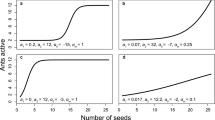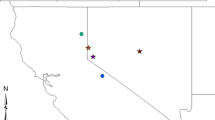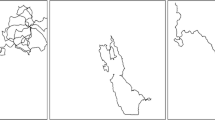Abstract
We investigated the effect of substrate roughness on load selection in the seed-harvester ant Messor barbarus. Ants were forced to travel either on sand or on gravel to reach a seed patch containing seed fragments of different weights. We hypothesized that foragers travelling on a rough substrate could either increase their load as a result of the increased distance travelled (due to a more sinuous path and an increase in the vertical component of the path) or decrease their load because of the anticipated difficulty of moving with a heavy load on a rough surface. Our results were consistent with neither of these hypotheses: Load selection by ants did not depend on the roughness of the substrate encountered during their outbound trip. The main effect of substrate roughness was to slow down the progression of the ants and increase their probability of dropping or transferring heavy seeds on their way back to the nest, thus resulting in an overall reduction of the rate of seed return to the nest.




Similar content being viewed by others
References
Azcárate FM, Arqueros L, Sanchez AM, Peco B (2005) Seed and fruit selection by harvester ants, Messor barbarus, in Mediterranean grassland and scrubland. Funct Ecol 19:273–283. doi:10.1111/j.0269-8463.2005.00956.x
Azcárate FM, Peco B (2003) Spatial patterns of seed predation by harvester ants (Messor Forel) in Mediterranean grassland and scrubland. Insect Soc 50:120–126. doi:10.1007/s00040-003-0635-y
Azcárate FM, Peco B (2007) Harvester ants (Messor barbarus) as disturbance agents in Mediterranean grasslands. J Veg Sci 18:103–110. doi:10.1111/j.1654-1103.2009.05646.x
Baroni Urbani C, Nielsen MG (1990) Energetics and foraging behaviour of the European seed harvesting ant Messor capitatus. II. Do ants optimize their harvesting? Physiol Entomol 15:449–461. doi:10.1111/j.1365-3032.1990.tb00534.x
Bartholomew GA, Lighton JRB, Feener D (1988) Energetics of trail running, load carriage, and emigration in the column-raiding army ant Eciton hamatum. Physiol Zool 61:57–68. doi:10.1086/637980
Bates GH (1950) Track making by man and domestic animals. J Anim Ecol 19:21–28
Bernadou A, Fourcassié V (2008) Does substrate coarseness matter for foraging ants? An experiment with Lasius niger (Hymenoptera; Formicidae). J Insect Physiol 54:534–542. doi:10.1016/j.jinsphys.2007.12.001
Bhatkar AP, Whitcomb WH (1970) Artificial diet for rearing various species of ants. Fla Entomol 53:229–232
Burd M (2000) Body size effects on locomotion and load carriage in the highly polymorphic leaf-cutting ants Atta colombica and Atta cephalotes. Behav Ecol Sociobiol 11:125–131. doi:10.1093/beheco/11.2.125
Cerdan P (1989) Etude de la biologie, de l’écologie et du comportement des fourmis moissonneuses du genre Messor (Hymenoptera, Formicidae) en Crau. Dissertation, Université des Sciences et Technologies, Montpellier
Charnov EL (1976) Optimal foraging: the marginal value theorem. Theor Popul Biol 9:129–136. doi:10.1016/0040-5809(76)90040-X
Crist TO, MacMahon JA (1991) Individual foraging components of harvester ants: movement patterns and seed patch fidelity. Insect Soc 38:379–396. doi:10.1007/BF01241873
Crist TO, MacMahon JA (1992) Harvester ant foraging and shrub-steppe seeds: interactions of seed resources and seed use. Ecology 73:1768–1779. doi:10.2307/1940028
Crist TO, Wiens JA (1994) Scale effect of vegetation on forager movement and seed harvesting by ants. Oikos 69:37–46
Davidson DW (1978) Experimental tests of the optimal diet in two social insects. Behav Ecol Sociobiol 4:35–41. doi:10.1007/BF00302559
Detrain C, Pasteels JM (2000) Seed preferences of the harvester ant Messor barbarus in a Mediterranean mosaic grassland. Sociobiology 35:35–48
Detrain C, Tasse O (2000) Seed drops and caches by the harvester ant Messor barbarus: do they contribute to seed dispersal in Mediterranean grasslands? Naturwissenschaften 87:373–376. doi:10.1007/s001140050744
Detrain C, Tasse O, Versaen M, Pasteels JM (2000) A field assessment of optimal foraging in ants: trail patterns and seed retrieval by the European harvester ant Messor barbarus. Insect Soc 47:56–62. doi:10.1007/s000400050009
Dussutour A, Deneubourg JL, Beshers S, Fourcassié V (2009) Leaf-cutting ant Atta colombica adjusts their foraging behavior to the physical constraints of the environment. Anim Cogn 12:21–30. doi:10.1007/s10071-008-0165-0
Ferster B, Traniello J (1995) Polymorphism and foraging behavior in Pogonomyrmex badius (Hymenoptera: formicidae): worker size, foraging distance, and load size associations. Environ Entomol 24:673–678
Fewell JH (1987) Variation in foraging patterns of the western harvester ant, Pogonomyrmex occidentalis, in relation to variation in habitat structure. In: Jeanne RL (ed) Interindividual behavioural variability in social insects. Westview Press, Boulder, pp 257–282
Fewell JH (1988) Energetic and time costs of foraging in harvester ants, Pogonomyrmex occidentalis. Behav Ecol Sociobiol 22:401–408. doi:10.1007/BF00294977
Franks NR, Mallon EB, Bray HE, Hamilton MJ, Mischler TC (2003) Strategies for choosing between alternatives with different attributes: exemplified by house-hunting ants. Anim Behav 65:215–223. doi:10.1006/anbe.2002.2032
Gordon DM (2010) Ant encounters: interaction networks and colony behavior. Princeton University Press, Princeton
Helbing D, Keltsch J, Molnar P (1997) Modelling the evolution of human trail systems. Nature 388:450. doi:10.1038/40353
Holder Bailey K, Polis GA (1987) Optimal and central-place foraging theory applied to a desert harvester ant, Pogonomyrmex californicus. Oecologia 72:440–448. doi:10.1007/BF00377577
Jamon M (1994) An analysis of trail-following behaviour in the wood mouse, Apodemus sylvaticus. Anim Behav 47:1127–1134
Lighton JRB, Bartholomew GA, Feener DH (1987) Energetics of locomotion and load carriage and a model of the energy cost of foraging in the leaf-cutting ant Atta colombica. Physiol Zool 60:524–537. doi:10.1086/637912
Lighton JRB, Weier JA, Feener DH Jr (1993) The energetics of locomotion and load carriage in the desert harvester ant Pogonomyrmex rugosus. J Exp Biol 181:49–62
López F, Acosta FJ, Serrano JM (1993) Responses of the trunk routes of a harvester ant to plant density. Oecologia 93:109–113. doi:10.1007/BF00321199
Moll K, Roces F, Federle W (2010) Foraging grass-cutting ants Atta vollenweideri maintain stability by balancing their loads with controlled head movements. J Comp Physiol A 196:471–480. doi:10.1007/s00359-010-0535-3
Morehead SA, Feener DH (1998) Foraging behavior and morphology: seed selection in the harvester ant genus, Pogonomyrmex. Oecologia 114:548–555. doi:10.1007/s004420050479
Nielsen MG (2001) Energetic cost of foraging in the ant Rhytidoponera aurata in tropical Australia. Physiol Entomol 26:248–253. doi:10.1046/j.0307-6962.2001.00242.x
Orians GH, Pearson NE (1979) On the theory of central place foraging. In: Horn DJ, Stairs GR, Mitchell RD (eds) Analysis of ecological systems. Ohio State University Press, Columbus, pp 155–177
Powell S, Franks NR (2005) Caste evolution and ecology: a special worker for novel prey. Proc R Soc B 272:2173–2180. doi:10.1098/rspb.2005.3196
Pinheiro JC, Bates DM (2000) Mixed-effects models in S and S-PLUS. Springer, New York
Reyes JL, Fernández Haeger J (1999) Sequential co-operative load transport in the seed-harvesting ant Messor barbarus. Insect Soc 46:119–125. doi:10.1007/s000400050121
Reyes-Lopez JL (1987) Optimal foraging in seed-harvester ants: computer-aided simulation. Ecology 68:1630–1633. doi:10.2307/1939855
Reyes-López JL, Fernández-Haeger J (2001) Some factors determining size-matching in the harvester ant Messor barbarus: food type, transfer activity, recruitment rate and size-range. Insect Soc 48:118–124. doi:I10.1007/PL00001753
Rissing SW, Pollock GB (1984) Worker size variability and foraging efficiency in Veromessor pergandei Hymenoptera Formicidae. Behav Ecol Sociobiol 15:121–126. doi:10.1007/BF00299379
Rockwood LL, Hubbell SP (1987) Host–plant selection, diet diversity, and optimal foraging in a tropical leafcutting ant. Oecologia 74:55–61. doi:10.1007/BF00377345
Röschard J, Roces F (2002) The effect of load length, width and mass on transport rate in the grass-cutting ant Atta vollenweideri. Oecologia 131:319–324. doi:10.1007/s00442-002-0882-z
Ross JA, Matter SF, Roland J (2005) Edge avoidance and movement of the butterfly Parnassius smintheus in matrix and non-matrix habitat. Landscape Ecol 20:127–135. doi:10.1007/s10980-004-1010-8
Rudolph SG, Loudon C (1986) Load size selection by foraging leaf-cutter ants (Atta cephalotes). Ecol Entomol 11:401–410. doi:10.1111/j.1365-2311.1986.tb00319.x
Schoener TW (1979) Generality of the size–distance relation in models of optimal feeding. Am Nat 114:902–912. doi:10.1086/283537
Stephens DW, Krebs JR (1986) Foraging theory. Princeton University Press, Princeton
Taylor FW (1977) Foraging behavior of ants: experiments with two species of myrmecine ants. Behav Ecol Sociobiol 2:147–167. doi:10.1007/BF00361899
Torres-Contreras H, Vasquez RA (2004) A field experiment on the influence of load transportation and patch distance on the locomotion velocity of Dorymyrmex goetschi (Hymenoptera, Formicidae). Insect Soc 51:265–270. doi:10.1007/s00040-004-0737-1
Warburg I (2000) Preference of seeds and seed particles by Messor arenarius (Hymenoptera: Formicidae) during food choice experiments. Ann Entomol Soc Am 93:1095–1099
Weier J, Feener D (1995) Foraging in the seed-harvester ant genus Pogonomyrmex: are energy costs important? Behav Ecol Sociobiol 36:291–300. doi:10.1007/BF00167790
Wetterer JK (1991) Source distance has no effect on load size in the leaf-cutting ant, Atta cephalotes. Psyche 98:355–359
Wiens JA, Crist TO, With KA, Milne BT (1995) Fractal patterns of insect movement in microlandscape mosaics. Ecology 76:663–666. doi:10.2307/1941226
Willott SJ, Compton SG, Incoll LD (2000) Foraging, food selection and worker size in the seed harvesting ant Messor bouvieri. Oecologia 125:35–44. doi:10.1007/PL00008889
Wohlgemuth S, Ronacher B, Wehner R (2001) Ant odometry in the third dimension. Nature 411:795–798. doi:10.1038/35081069
Wolff A, Debussche M (1999) Ants as seed dispersers in a Mediterranean old-field succession. Oikos 84:443–452
Youngsteadt E, Nojima S, Haberlein C, Schulz S, Schal C (2008) Seed odor mediates an obligate ant–plant mutualism in Amazonian rainforests. PNAS U S A 105:4571–4575. doi:10.1073/pnas.0708643105
Zollikofer CPE (1994) Stepping patterns in ants. 3. Influence of load. J Exp Biol 192:119–127
Acknowledgements
A.B. was financed by a doctoral grant from the Fundació Crèdit Andorra.
Ethical standards
The experiments comply with the current laws of the country in which they were performed.
Conflict of interest
The authors declare that they have no conflict of interest.
Author information
Authors and Affiliations
Corresponding author
Additional information
Communicated by L. Sundström
Rights and permissions
About this article
Cite this article
Bernadou, A., Espadaler, X., Dos-Reis, V. et al. Effect of substrate roughness on load selection in the seed-harvester ant Messor barbarus L. (Hymenoptera, Formicidae). Behav Ecol Sociobiol 65, 1763–1771 (2011). https://doi.org/10.1007/s00265-011-1184-4
Received:
Revised:
Accepted:
Published:
Issue Date:
DOI: https://doi.org/10.1007/s00265-011-1184-4




